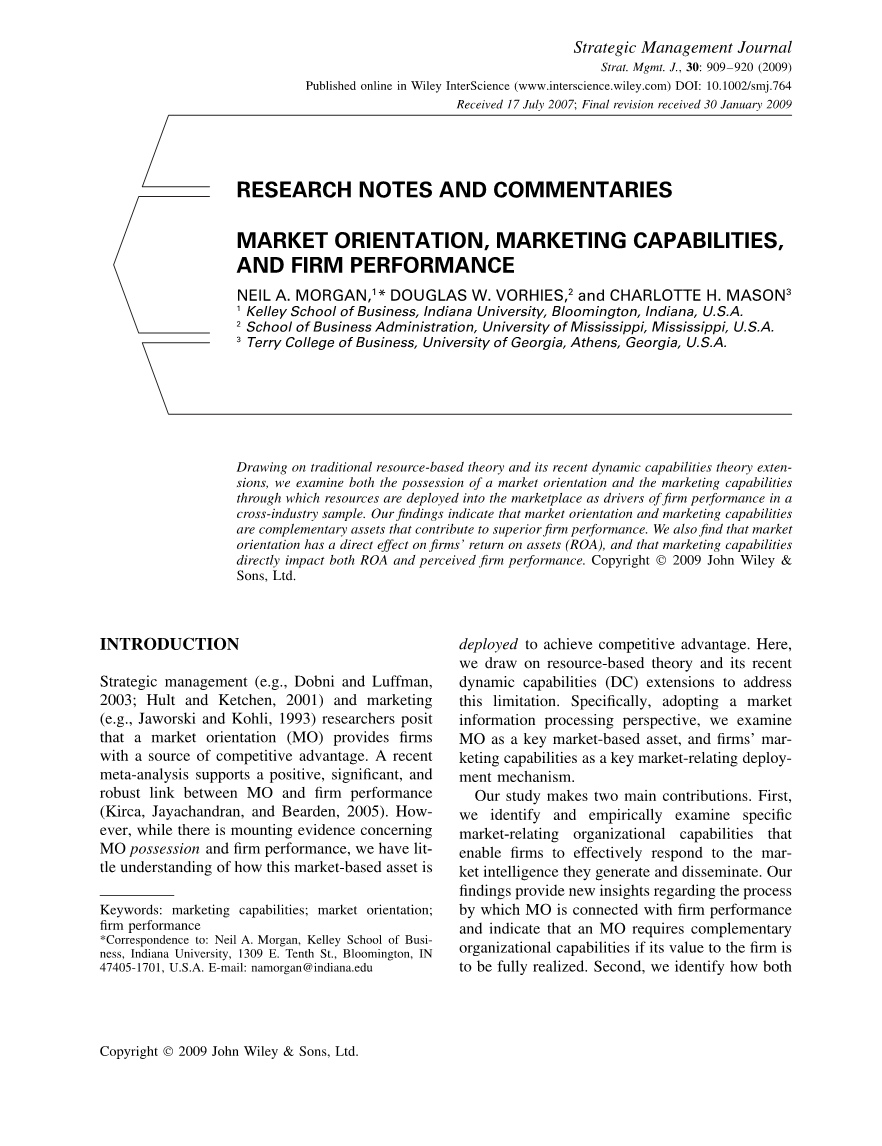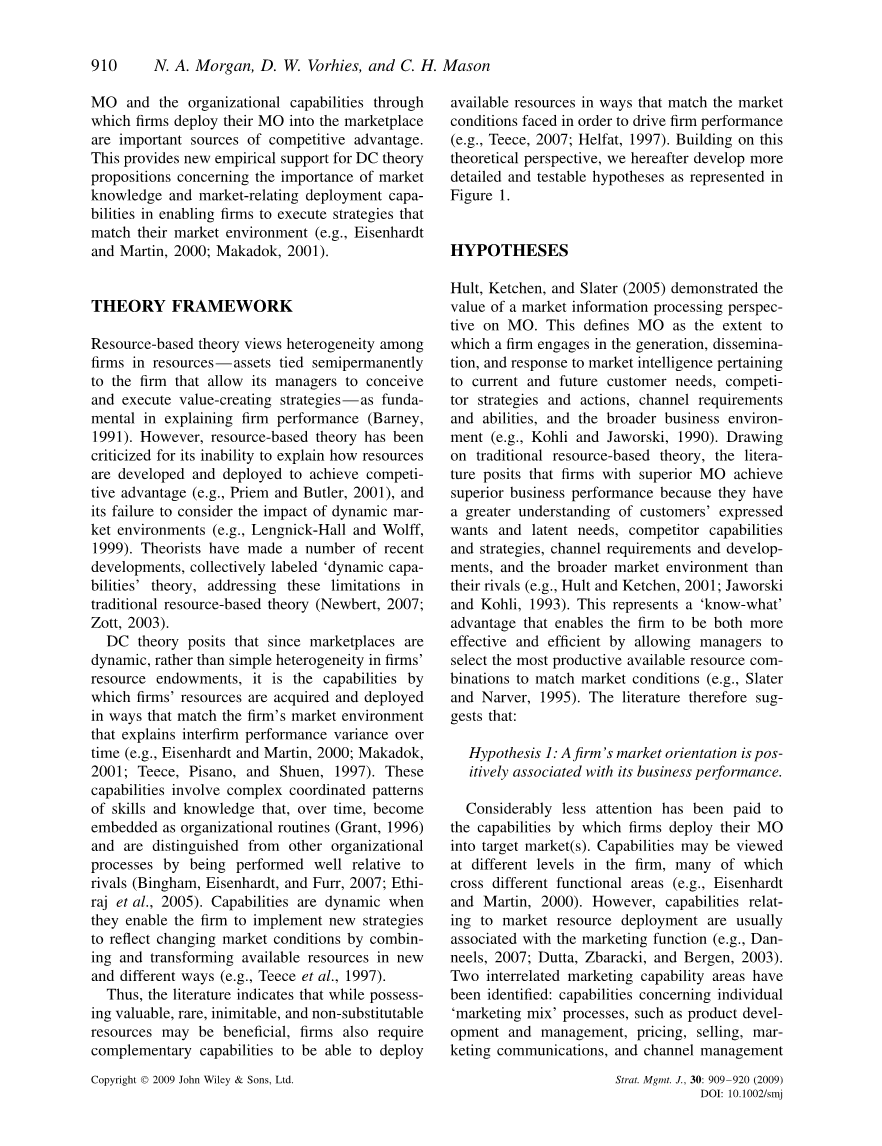

英语原文共 12 页,剩余内容已隐藏,支付完成后下载完整资料
RESEARCH NOTES AND COMMENTARIESMARKET
ORIENTATION, MARKETING CAPABILITIES, AND FIRM PERFORMANCE
Author(s):NEIL A. MORGAN,1* DOUGLAS W. VORHIES,2 and CHARLOTTE H. MASON3
1.Kelley School of Business, Indiana University, Bloomington, Indiana, U.S.A.
2.School of Business Administration, University of Mississippi, Mississippi, U.S.A.
3.Terry College of Business, University of Georgia, Athens, Georgia, U.S.A.
Strategic Management Journal Strat. Mgmt. J., 30: 909–920 (2009)
Published online in Wiley InterScience (www.interscience.wiley.com) DOI: 10.1002/smj.764
Received 17 July 2007; Final revision received 30 January 2009
对于市场导向、营销能力和公司绩效之间关系的研究记录和评价
Drawing on traditional resource-based theory and its recent dynamic capabilities theory extensions, we examine both the possession of a market orientation and the marketing capabilities through which resources are deployed into the marketplace as drivers of firm performance in a cross-industry sample. Our findings indicate that market orientation and marketing capabilities are complementary assets that contribute to superior firm performance. We also find that market orientation has a direct effect on firmsrsquo; return on assets (ROA), and that marketing capabilities directly impact both ROA and perceived firm performance. Copyright 2009 John Wiley amp; Sons, Ltd.
摘要:利用传统的资源基础理论及其最新的动态能力理论,我们在一个跨行业的样本中,研究了资源作为企业绩效驱动因素被部署到市场的市场导向和营销能力。我们的研究结果表明,市场导向和营销能力是互补的资产,且有助于提高企业业绩。我们还发现,市场导向对企业的资产回报率(ROA)有直接影响,营销能力直接影响公司的资产回报(ROA)和可见的企业绩效。Copyright 2009 John Wiley amp; Sons, Ltd.
INTRODUCTION(介绍)
Strategic management (e.g., Dobni and Luffman, 2003; Hult and Ketchen, 2001) and marketing (e.g., Jaworski and Kohli, 1993) researchers posit that a market orientation (MO) provides firms with a source of competitive advantage. A recent meta-analysis supports a positive, significant, and robust link between MO and firm performance (Kirca, Jayachandran, and Bearden, 2005). How-ever, while there is mounting evidence concerning MO possession and firm performance, we have little understanding of how this market-based asset is deployed to achieve competitive advantage. Here, we draw on resource-based theory and its recent dynamic capabilities (DC) extensions to address this limitation. Specifically, adopting a market information processing perspective, we examine MO as a key market-based asset, and firmsrsquo; marketing capabilities as a key market-relating deployment mechanism.
战略管理 (e.g., Dobni and Luffman, 2003; Hult and Ketchen, 2001) 和市场 (e.g., Jaworski and Kohli, 1993)研究人员假设市场导向(MO)为企业提供了竞争优势的来源。最近的一项meta分析支持了市场导向(MO)和企业绩效之间存在积极、显著和稳健的联系(Kirca, Jayachandran, and Bearden, 2005)这一理论。然而,虽然有越来越多的证据表明,拥有市场导向(MO)和企业绩效之间有联系,我们对如何利用这一市场资产来获得竞争优势的了解却很少。在这里,我们利用基于资源的理论及其最近的动态能力(DC)扩展来解决这一限制。具体地说,我们采用市场信息处理的视角,将移动营销作为一种关键的市场资产,将企业营销能力作为一种关键的市场相关配置机制进行了研究。
Our study makes two main contributions. First, we identify and empirically examine specific market-relating organizational capabilities that enable firms to effectively respond to the market intelligence they generate and disseminate. Our findings provide new insights regarding the process by which MO is connected with firm performance and indicate that an MO requires complementary organizational capabilities if its value to the firm is to be fully realized. Second, we identify how both MO and the organizational capabilities through which firms deploy their MO into the marketplace are important sources of competitive advantage. This provides new empirical support for DC theory propositions concerning the importance of market knowledge and market-relating deployment capabilities in enabling firms to execute strategies that match their market environment (e.g., Eisenhardt and Martin, 2000; Makadok, 2001).
我们的研究主要有两个贡献。首先,我们确定并实证检验了特定的市场相关组织能力,这种市场相关组织能力使企业能够有效地响应其产生和传播的市场情报。我们的发现提供了关于市场导向(MO)与企业绩效之间联系的新见解,并表明如果要充分实现市场导向(MO)对企业的价值,它还需要相补充的市场组织能力。其次,我们确定了市场导向(MO)和企业能够将其市场导向(MO)部署到市场的组织能力是竞争优势的重要来源。这为动态能力(DC)理论命题提供了新的实证支持,该命题涉及到市场知识和与市场相关的部署能力在使企业能够执行与其市场环境相匹配的战略时候的重要性(e.g., Eisenhardt and Martin, 2000; Makadok, 2001)。
THEORY FRAMEWORK(理论框架)
Resource-based theory views heterogeneity among firms in resources—assets tied semipermanently to the firm that allow its managers to conceive and execute value-creating strategies—as fundamental in explaining firm performance (Barney, 1991). However, resource-based theory has been criticized for its inability to explain how resources are developed and deployed to achieve competitive advantage (e.g., Priem and Butler, 2001), and its failure to consider the impact of dynamic market environments (e.g., Lengnick-Hall and Wolff, 1999). Theorists have made a number of recent developments, collectively labeled lsquo;dynamic capabilitiesrsquo; theory, addressing these limitations in traditional resource-based theory (Newbert, 2007; Zott, 2003).
基于资源的理论认为,企业间资源的异质性是解释企业绩效的基础 (Barney, 1991)。然而,基于资源的理论一直受到批评,因为它无法解释如何开发和部署资源以获得竞争优势(e.g., Priem and Butler, 2001),也未能考虑动态市场环境的影响(e.g., Lengnick-Hall and Wolff, 1999)。近年来,理论界取得了一系列新进展,统称为“动态能力”理论,解决了传统资源基础理论的这些局限性(Newbert, 2007;Zott, 2003)。
DC theory posits that since marketplaces are dynamic, rather than simple heterogeneity in firmsrsquo; resource endowments, it is the capabilities by which firmsrsquo; resources are acquired and deployed in ways that match the firmrsquo;s market environment that explains inter-firm performance variance over time (e.g., Eisenhardt and Martin, 2000; Makadok, 2001; Teece, Pisano, and Shuen, 1997). These capabilities involve complex coordinated patterns of skills and knowledge that, over time, become embedded as
全文共48462字,剩余内容已隐藏,支付完成后下载完整资料
资料编号:[2323]


